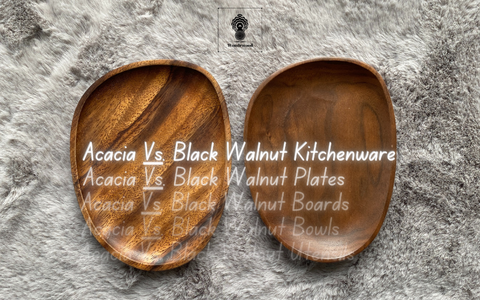
If you're trying to decide between acacia or walnut wood kitchenware, you are probably wondering what the main differences are, and how it will affect the everyday use, reliability and maintenance of your wooden kitchenware or furniture.
- For example, did you know that acacia wood is denser but walnut wood is heavier? But how does that affect how you care for it?
Well, we did a deep dive and compared acacia with walnut wood in every category to determine the pros, cons, and what you should watch out for to avoid potentially regretting your choice further down the line.
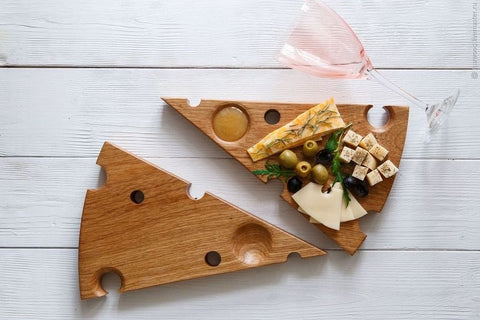
Popular for a Reason
Both acacia and black walnut are among the most popular and widely used species for items like wooden kitchen and dining-ware. But, they do have some key differences that might make you lean towards choosing a product made of one wood type over the other.
In this quick guide, we'll lay out the pros and cons of both acacia and walnut wood when used in the home, but particularly for kitchenware. You'll also learn about the main characteristics, benefits, and drawbacks of both walnut wood and acacia wood kitchenware.
TABLE OF CONTENTS
- Brief Overview of Acacia Wood & Walnut Wood
- Durability & Water-Resistance
- Bacteria, Germs & Food-Safety
- Scratch-Resistance
- Cracks and Warping
- Appearance & Aesthetics
- Maintenance & Care
- Sustainability
- Cost Vs Value
- Use-Cases in the Home
- What Do You Prioritise Most?
- Final Thoughts
Ok, let's quickly answer 3 simple questions that you probably will also have:
Quick question 1: Do acacia and walnut wood go together?
Yes, acacia and walnut wood compliment each other nicely, both are strong hardwoods with contrasting colours that go together well and share some common characteristics.
Quick quesiton 2: Are walnut wood and acacia wood similar?
Acacia and walnut wood are similar in that they are both highly desired hardwoods commonly used in the home, they also both are known for their striking appearance and strong durability.
Quick question 3: What are the main differences between acacia and walnut wood?
- Acacia wood is usually lighter in colour, slightly more durable, and more resistant to moisture. It can even be great for outdoor use, as well as for kitchenware that will get plenty of daily use.
- Walnut wood is darker and heavier with close-knit grain often appearing in swirls or wave-like patterns. It's also known for strength, and walnut is seen as a more premium wood, often used for upscale furniture. Walnut's higher price reflects its quality, slower growth and exclusivity compared to acacia.
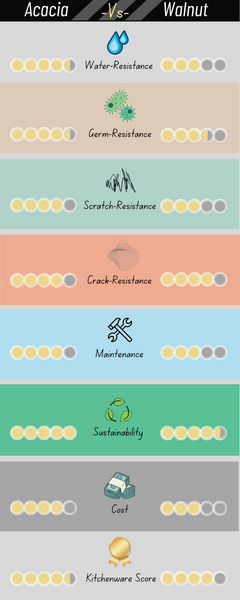
Acacia Vs Walnut Wood Overview:
Acacia
With naturally-occurring acacia oil that protects against both water and germs easily, and a very high density to protect from scratches and scuffs, acacia wood is a great choice for a range of uses in the home - particularly for kitchenware.
Acacia wood is known for its warm, honey-golden colouration and a dark grain that often appears as a striped pattern. As well as having a striking appearance, acacia is also an incredibly tough and resilient wood.
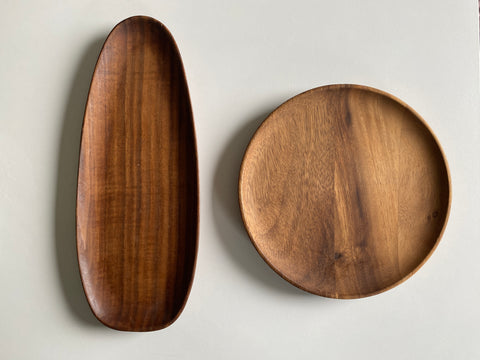
Black Walnut & European Walnut
Walnut wood, and in particular, black walnut has dark chocolate-brown tones with a straight or swirled/wavy, tight-knit grain.
Like acacia, walnut wood is also a very strong hardwood, but is both heavier and darker than acacia. Black walnut is often considered a 'luxury' or premium wood, thanks to its slower growth, smoothness, strength, and very dark colouration - all of which contribute to it's slightly higher price tag, but more on that below.
2. Acacia Vs Black Walnut Wood Durability:

Water-Resistance
Acacia's Water-Resistance:
Acacia's naturally high resistance to water makes it an excellent choice for use in the kitchen. As you know, all kitchenware will inevitably come into contact with liquids, juices and oils throughout its day-to-day use.
What makes acacia wood so waterproof?
- Acacia trees have naturally-occuring oil that is highly protective against water, fungus and even bacteria (more on that below). Acacia oil stays in the wood even after the tree is cut down, dried and crafted into a piece of kitchenware. This provides an additional layer of life-long protection throughout the entire piece of wood, before any sealants are added to the surface.
- Not only does this make acacia wood great for kitchenware, it means it's often used for outdoor furniture and window frames thanks to its incredible water-resistance. In fact, acacia tops the ranks among all known wood types for water-resistance.
Black Walnut's Water-Resistance:
Black walnut is a little less resilient against water and so walnut kitchenware will generally be a bit less forgiving if you leave it soaking for a few hours in a wet sink, for example. Prolonged water exposure can leave behind dark stains on walnut wood if left for too long.
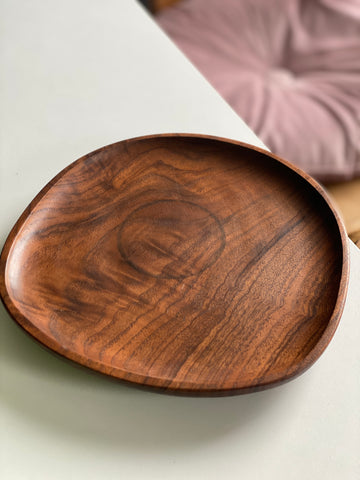
How can I stop my wooden kitchenware from staining?
- A good way to safeguard against this is to make sure your wooden kitchenware has an adequate layer of sealant and is not left soaking in water (or leaving large puddles on it) for too long.
- Any water left over an hour or two will start to stain the wood.
- If you do encounter a stain on your wooden ware, here's how you can easily remove stains or odours from wood again.
As black walnut is not as water-resistant as acacia, it can need a little more maintenance and care compared with acacia - but, for all wooden kitchenware, we'd recommend gently hand-washing and drying after use.

3. Acacia vs Walnut: Bacteria, Germs & Food-Safety
Acacia's Antibacterial-Oils:
As you saw above, acacia's somewhat 'magical' oils have antibacterial, antifungal and water-repelling properties, making it a very hygienic option for items like wooden kitchen utensils and cutting boards.
- This makes acacia a great wood for kitchenware that will be wet more often like cutting boards, cooking utensils and salad bowls.

Walnut's Antibacterial Properties:
While black walnut wood is food-safe, it lacks the anti-bacterial oils that acacia has. So, walnut wood may also need a little more regular cleaning and care when used for something like a cutting board that gets frequent use.
Did you know...
- While black walnut wood does not contain anti-bacterial oils, any wooden cutting board will still provide more protection against bacteria when compared to a plastic cutting board.
- Something else to note: walnut oil (the oil taken from the actual walnut nut) makes a great sealant for wood, and even has antibacterial qualities. You can purchase walnut oil and apply it to your walnut wood kitchenware to provide further protection from bacteria, fungus and germs.
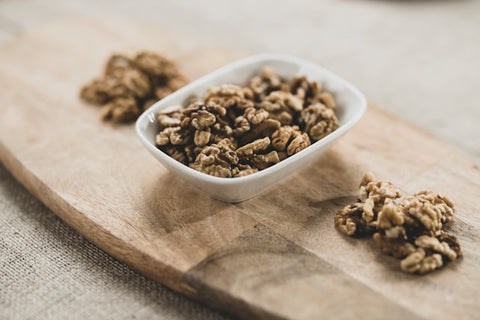
Wood's natural structure is designed to absorb (and destroy) bacteria and germs on the wood surface.Is wood actually food-safe, what happens to bacteria?
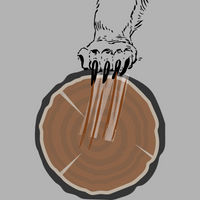
4. Acacia vs Walnut: Scratch-Resistance
Acacia's Scratch-Resistance
Acacia's hardness makes it well-able to withstand scuffs and scratches, which will make sure your wood plates, bowls, and boards keep a smooth surface over time. This also means it will have a protective seal for longer without the need to reapply oil.
How hard is acacia wood, you think?
- Well, for context, marble (yes, as in the incredibly hard stone used for countertops) has a density of 80 lbs/cubic foot (1.3 tonnes / cubic meter).
- In comparison, acacia wood has a density of 62 lbs/cubic foot (1 tonne / cubic meter).
- While walnut is heavier than acacia, it has a lower density of 41.2 lbs/cubic foot (6.6 tonnes / cubic meter) - which is still not to be overlooked and very respectable/strong among hardwoods.
Black Walnut's Scratch Resistance
Black walnut is still a tough hardwood but will be slightly more prone to surface marks and scratches from things like forks and knives than acacia will be.
So again, walnut will need a little more care in handling to preserve a smooth surface over time as it gets used for things like cutting boards and plates that get daily use with metal cutlery.
Side note: The nice thing about all wood is that if the surface gets scratched or marked in some way, it is easily repaired at home with a little sanding and oiling. There are even plenty of natural recipes for making your own wood sealant oil at home too!

5. Acacia vs Walnut: Cracking & Warping
Both walnut and acacia wood are very resiliant against warping and cracking.
This is good news for your walnut and acacia wood kitchenware as it will last much longer, even when exposed to a range of humidity levels. Picture your wooden spoons and spatulas that might be in a boiling hot sauce one minute - and then getting washed and left to dry out again, day after day...
- For acacia wood plates, bowls, utensils and other kitchenware, acacia's natural oils and water resistance play a big part in protecting the wood from cracking or warping over time.
- Black walnut is also great at resisting cracks or warping due to it being a heavy, dense wood with a tight-knit grain. In prolonged humid conditions, walnut might be a bit more prone to warping than acacia - but the difference is minimal.

By the way, should you wash wooden kitchenware in the dishwasher?
If possible, it's always best to wash any wooden kitchenware and tableware like wood plates, boards, utensils, cups or bowls by hand with warm water and soap. Then allow to fully air-dry after wiping down with a teatowel or cloth.
Saying this, you can still put your wooden kitchenware in the dishwasher every once in a while. For longevity, try to use the lowest heat setting and the shortest wash cycle, and refrain from washing wood in the dishwasher too often.
Frequently washing wood kitchenware in the dishwasher will cause it to lose its outer protective seal and make it more prone to cracks, twists and warping.
For a full wooden kitchenware care guide, find the answers to all of your questions here.

6. Acacia vs Walnut: Appearance & Aesthetics
Acacia's Warm Hues:
The golden tones of acacia wood and its wavy grain pattern give it a warm and intriguing look. The grain often has contrasting dark streaks and stripes amongst lighter ones and adds a lot of visual interest to a table setting or dining spread.
Black Walnut's Rich Aesthetic:
Black walnut's deep, chocolate-brown colour, smoothness and close grain give a sense of sophistication and esteem. This, along with its strength and durability makes walnut wood - and especially black walnut - an attractive choice for premium kitchenware and servingware.
Walnut wood can also have wavy or swirled patterns throughout the fine grain, together with a smooth and heavy feel. Walnut wood definitely has a luxurious look that draws you in; it's sometimes said that black walnut has an all-round sensory experience beyond what many other types of wood have.
- As with black walnut's luxurious appearance, it tends to elevate the feeling of the space it occupies and brings a sophisticated aesthetic to kitchenware and furniture. Thanks to this, walnut is a great choice for a conversation piece, or diningware and servingware to make it feel like a special occasion.

7. Acacia vs Walnut: Maintenance & Care
Acacia's Low-Maintenance Appeal:
Acacia wood is generally low-maintenance, requiring minimal care to preserve its natural beauty and durability.
- Regular cleaning after each use, and occasional oiling or resealing once every 1-2 years is usually sufficient to keep acacia kitchenware in top condition, as long as you're not using it for a dartboard, that is.
Don't forget: If you want to find out more about how to properly care for wood kitchenware, you can read our full wooden kitchenware care guide, and learn how to make your own food-safe wood sealant at home here.
Black Walnut's High-End Appeal:
Black walnut may demand a little more attention than acacia, depending on the day-to-day use. So occasional maintenance is needed slightly more often for walnut than for acacia to ensure the wood's overall lifespan and appearance.
- Protective coatings and occasional re-oiling can help maintain the rich color and finish of your black walnut kitchenware. You can apply a food-safe protective wood sealant to your wood kitchenware once or twice a year to keep it in tip-top shape, looking smooth and glossy.

8. Acacia vs Walnut: Sustainability
Acacia's Rapid Growth:
- Acacia is often considered a very sustainable wood choice because of its fast growth rate and the ability to thrive in a range of climates and environments. This means acacia wood can be renewed relatively quickly and does not need very specific conditions (climate, soil type, etc) to grow.
A sustainable alternative to tropical hardwood:
- Acacia wood has a similar density, hardness and beauty to some rare species of tropical hardwood - except that acacia is far more sustainable thanks to its grow-anywhere-quickly-ness.

Black Walnut's Slower Growth:
With black walnut's slower growth rate, and a smaller range of where it can grow, this means that it technically is not as sustainable as acacia. However, sustainable sourcing and responsible forestry practices are an essential part of black walnut production, and with laws in place to mitigate the environmental footprint of black walnut wood forestry, it is also a sustainable choice as a high-quality material.
- As a slower-growing species compared with acacia, black walnut is native to North America and most of the black walnut today is still grown in the US in places like Indiana, Ohio, Missouri, Kentucky, and Tennessee.
- Walnut's slower growth produces wood with straight, finer grain, and so gives an impression of perfection and 'esteem' that it gathered over a longer growing lifetime. This also means that an item made of walnut takes longer to produce than if it was made of acacia. All of these factors contribute to the higher price commanded by black walnut and European walnut.

9. Acacia vs Walnut: Cost vs. Value
Acacia's Affordability:
- While acacia is not as cheap as lower quality or less desirable types of wood like pine and beech, acacia wood is generally more budget-friendly than black walnut. This makes acacia an accessible choice for a wide range of people who still want high quality and long-lasting wood kitchenware.
- The affordability of acacia wood allows more people to enjoy the benefits of wooden kitchenware and dinnerware without having to fork out (pun intended) too much. What's more, is the durability and beauty of acacia make it an overall great bang for your buck in anyone's book.
Black Walnut's Higher Price Point:
- Black walnut is considered a premium wood for all of the reasons already mentioned (slower growth rate, dense grain, strength, and richer colour) which influence the value. All of these features are reflected in black walnut's higher price point when compared to acacia.
- The luxurious appearance and somewhat limited availability also add to the higher cost of black walnut kitchenware, and that's why walnut wood is often used for high-end pieces of cabinetry and furniture, as well as for kitchenware and other home decor.
- Admittedly, when you hold an item made of black walnut, it does make that item feel that bit more special compared with many other types of wood because of how 'premium' it feels.

10. Acacia vs Walnut: Use-Cases in the Home
There are many different use cases for both acacia and walnut for wooden items in your home. When it comes down to it, both acacia and walnut are extremely dense, strong and striking hardwoods which makes for great kitchenware, furniture or decor.
What is acacia wood best for?
Acacia wood is great for use cases where it might get more frequent use, some wear-and-tear, and be exposed to the elements or more extreme conditions. The natural oils in acacia wood kitchenware will give it a great added resistance against water, bacteria or germs, and its high density will protect it from scratches, scuffs and cracks.
Acacia wood is ideal for:
- Cutting boards
- Plates & bowls
- Cups
- Cooking utensils
- Cutlery
- Window frames
- Benches and tables (indoor or outdoor)
What is walnut wood best for?
Black walnut has a premium quality and gives a sense of luxury. Because of this, walnut is usually reserved for premium cabinetry, furniture and homeware, and of course kitchen and diningware.
Walnut wood items are therefore often considered more premium, extravagant or impressive and so may have extra sentimental or special value to the owner.
Walnut wood is ideal for:
- Serving platters & trays
- Charcuterie or cheese boards
- Rolling pins
- Desk accessories and storage
- High-end furniture & cabinetry
- Chairs & shelving
- Conversation pieces & decor
When choosing walnut wood for your kitchenware, bear in mind that walnut will require a little more upkeep than acacia to keep the wood looking good-as-new in tip-top condition.
- This is especially the case if the item is going to be exposed to frequent washing and exposure to sharp objects.
- Ideal use cases for black walnut wood in your kitchen and dining collection are for items that will leave a strong impression or become a conversation piece. Things like serving platters, charcuterie boards and even decor.
Acacia Vs Walnut Summarised:
Acacia:
- Acacia kitchenware is well-suited for everyday use as a versatile and durable option for daily cooking and dining. It also looks great with beautiful colours and grain patterns.
- Acacia's resilience to water, scratches, and warping makes it an ideal choice for functional and practical kitchenware that also looks great.
- In addition to wood kitchenware, acacia is often used in outdoor settings as it's incredibly water-resistant, topping the ranks among all wood types for water-resistance.
Black Walnut:
- Black walnut kitchenware is perfect for special occasions or high end experiences and table settings, adding a touch of elegance to the experience.
- While walnut may be slightly more susceptible to wear than acacia, its premium qualities make it a preferred choice for elevated occasions or showcasing dishes in food photography for example.
Still can't decide?What's more important to you:
Which Wood is Best for Your Kitchenware?
If you're still trying to decide between black walnut wood or acacia for your kitchenware or home decor, consider your preferences for which qualities or characteristics you prioritise most.
-
Do you put ease of maintenance and durability above all else? Acacia is probably for you.
- Or -
- Do you want your wooden piece to mean more to you and be a conversation piece? If so, then black walnut is likely the way to go.
Regardless of which wood you choose, both acacia and walnut wood are excellent choices for anywhere in your home and will last many lifetimes if given some basic care. At the end of the day, a large part of the decision will come down to personal taste - some people prefer the look of darker wood like black walnut, and others will prefer the lighter tones and striped patterns of acacia wood.
- Balancing durability, appearance, and maintenance is key when choosing between acacia and black walnut.
- Thinking about your specific needs and priorities will guide you toward the wood type that aligns best with your daily needs, habits and personal taste.
Final thoughts
Shop:
- All Wood & Glass Kitchenware
- Plates & Bowls
- Cups, Coasters & Drinkware
- Boards & Utensils
- Walnut Wood Items
Read:

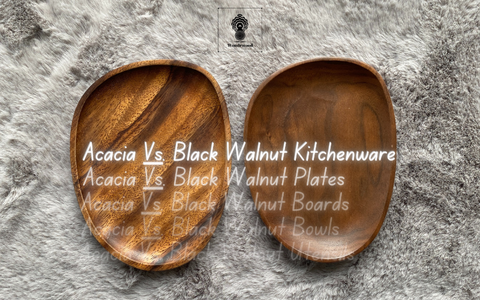
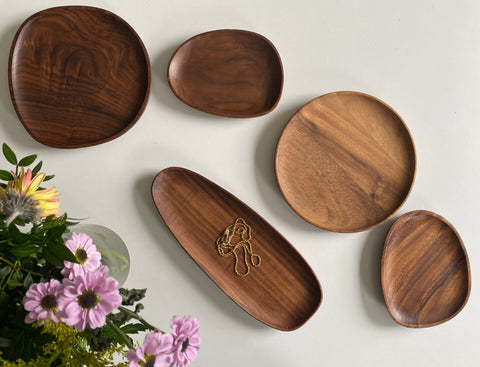
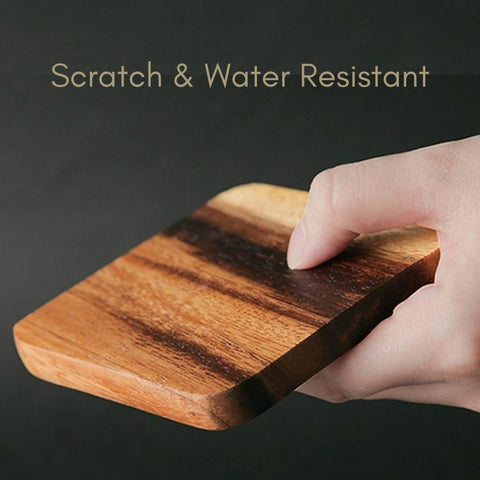


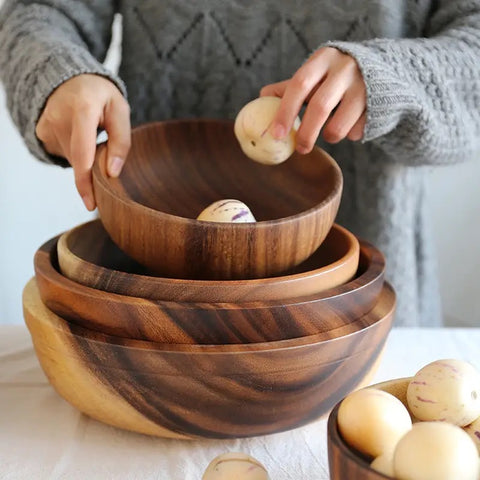
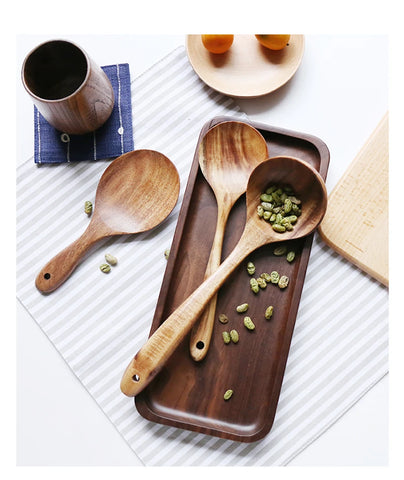


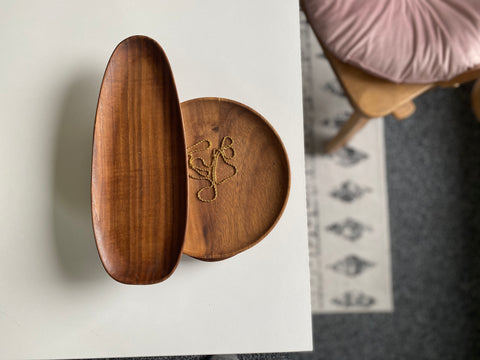


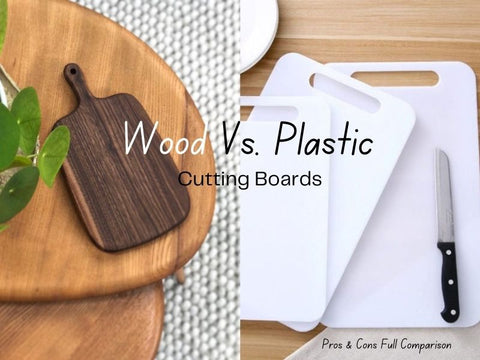
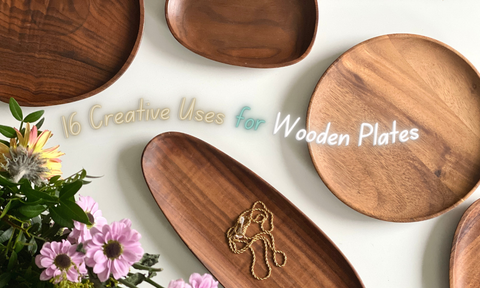
Comments (0)
There are no comments for this article. Be the first one to leave a message!